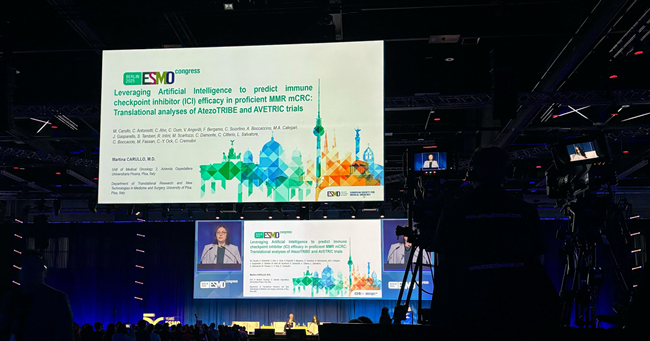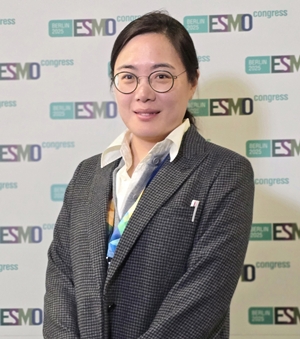- "AI pathology analysis changes trt paradigm…Lunit presents"
- by Hwang, byoung woo | translator Hong, Ji Yeon | Oct 23, 2025 06:11am
The results are particularly significant as Lunit demonstrated that AI can distinguish treatment response in a subset of proficient mismatch repair (pMMR) colorectal cancer (CRC) patients, a group that typically shows little response to immunotherapy.
DailyPharm met with Im Yu-ju, Medical Director of Lunit's Oncology Group (Hematology-Oncology Specialist), at ESMO 2025 to discuss the clinical significance and future vision of the research.

"Predicting treatment response from a single Slide... AI biomarker proves utility"
Lunit presented two abstracts utilizing its AI biomarker platform, Lunit SCOPE.
In particular, Oral Presentation detailing the results of a joint study with Professor Chiara Cremolini's research team at the University of Pisa garnered attention.
The study's core objective was to predict the therapeutic effect of atezolizumab (Tecentriq) combination therapy using Lunit's AI pathology platform, 'Lunit SCOPE.'
Im explained, "pMMR colorectal cancer is a notoriously intractable cancer that barely responds to immunotherapy. However, this study allowed us to identify a specific patient subgroup that benefits from the addition of immunotherapy."
Im emphasized, "We quantified the tumor microenvironment (TME) using only conventional H&E (Hematoxylin & Eosin-stained slide) slides, without the need for new tests or tissue collection, to predict treatment response. This result shows that AI can possess clinical utility as a biomarker."
H&E slides are standard stained tissue slides made from most patient specimens during pathological diagnosis. The clinical applicability is high because they can be used without additional testing.
In the study, researchers analyzed pathology slides from 161 patients using Lunit SCOPE to quantify the density of six cell types, including lymphocytes and tumor cells. Subsequently, they stratified patients into two groups (A/B).
The analysis showed that in the atezolizumab combination group, Group A demonstrated improvement in both progression-free survival (PFS) and overall survival (OS) compared to Group B. Notably, this difference was observed only in the combination arm, but not in the chemotherapy monotherapy group, proving Lunit SCOPE to be an immunotherapy-specific predictive indicator.
"AI incorporated complex immune response...AI refines tumor microenvironment analysis"
The key finding of this research is its complex interpretation of the tumor microenvironment (TME), moving beyond simple cell density analysis.
Im stated, "The response to immunotherapy is a comprehensive result of complex immune factors, including T-cell infiltration, antigen presentation pathways, and neoantigens, not just PD-L1 expression." She added, "Lunit SCOPE quantifies these multi-layered variables through AI pathology analysis and presents them in an interpretable format."

Im added, "Along with lymphocyte distribution, the proportion of dividing tumor cells was the highest contributor to predicting response," and said, "AI has overcome the limitations of conventional single-factor-based biomarkers."
Furthermore, Im said, "Although it varies by slide size, the analysis of a single slide typically takes 5–10 minutes. Even large-volume data can be processed within tens of minutes." She stated, "This speed allows the results to be immediately referenced concurrently with the clinical interpretation process."
Lunit, which has attended ESMO for five consecutive years since 2021, is leveraging this research to expand collaboration discussions with global pharmaceutical companies.
Im said, "Since many immune checkpoint inhibitors are already approved, collaboration is more active in companion diagnostics for subsequent indications and new drug development, rather than new clinical trials," and added, "We are accumulating evidence through investigator-initiated clinical trial data,"
"We are concurrently researching biomarkers for next-generation anti-cancer drugs like BiTE (Bispecific T-cell Engager) and ADC based on Lunit SCOPE IO," said Im and mentioned, "Our goal is to establish the technology as a practical treatment predictive tool through collaboration with partner pharmaceutical companies from the clinical trial stage."
"AI, a New Partner in Drug Development... Expanding to ADC and TKI"
At the annual ESMO conference, presentations on new modalities, such as ADCs, are consistently featured alongside those on immunotherapies. Lunit is also expanding its AI biomarker research in these areas.
Im stated, "In the ADC field, global pharmaceutical companies are actively adopting digital pathology AI-based Companion Diagnostics (CDx), where Lunit's analysis technology can significantly contribute."
Lunit is currently developing biomarkers for ADC drugs using IHC analysis of immunostained slides and is also building a TKI response-prediction model using morphological pattern analysis.
Im also added, "If AI quantifies drug-specific response patterns, it will allow us to connect both companion diagnostics and patient-specific treatment in the future."
At this ESMO Congress 2025, Lunit also presented research on renal cell carcinoma and non-small cell lung cancer in addition to colorectal cancer.
In the renal cell carcinoma study, the immune-activated patient group showed a significantly higher ORR of 60.5% in the nivolumab + ipilimumab combination therapy compared to the non-activated group (23.2%). In the NSCLC study, the immune-activated phenotype showed a superior response in a Japanese multi-center patient cohort, confirming the reproducibility of the AI model.
Im said, "AI pathology analysis is not limited to a specific cancer type." She added, "We are conducting multi-cancer expansion studies to apply it to early treatment stages and adjuvant therapies."
Ultimately, the assessment is that AI is no longer a future technology but becoming established as a practical tool that is changing treatment strategies in real-world clinical settings.
Im concluded, "AI pathology analysis is not limited to a specific cancer type. Lunit is conducting multi-cancer expansion studies so that it can be applied to early treatment stages and adjuvant therapies."
-

- 0
댓글 운영방식은
댓글은 실명게재와 익명게재 방식이 있으며, 실명은 이름과 아이디가 노출됩니다. 익명은 필명으로 등록 가능하며, 대댓글은 익명으로 등록 가능합니다.
댓글 노출방식은
댓글 명예자문위원(팜-코니언-필기모양 아이콘)으로 위촉된 데일리팜 회원의 댓글은 ‘게시판형 보기’와 ’펼쳐보기형’ 리스트에서 항상 최상단에 노출됩니다. 새로운 댓글을 올리는 일반회원은 ‘게시판형’과 ‘펼쳐보기형’ 모두 팜코니언 회원이 쓴 댓글의 하단에 실시간 노출됩니다.
댓글의 삭제 기준은
다음의 경우 사전 통보없이 삭제하고 아이디 이용정지 또는 영구 가입제한이 될 수도 있습니다.
-
저작권·인격권 등 타인의 권리를 침해하는 경우
상용 프로그램의 등록과 게재, 배포를 안내하는 게시물
타인 또는 제3자의 저작권 및 기타 권리를 침해한 내용을 담은 게시물
-
근거 없는 비방·명예를 훼손하는 게시물
특정 이용자 및 개인에 대한 인신 공격적인 내용의 글 및 직접적인 욕설이 사용된 경우
특정 지역 및 종교간의 감정대립을 조장하는 내용
사실 확인이 안된 소문을 유포 시키는 경우
욕설과 비어, 속어를 담은 내용
정당법 및 공직선거법, 관계 법령에 저촉되는 경우(선관위 요청 시 즉시 삭제)
특정 지역이나 단체를 비하하는 경우
특정인의 명예를 훼손하여 해당인이 삭제를 요청하는 경우
특정인의 개인정보(주민등록번호, 전화, 상세주소 등)를 무단으로 게시하는 경우
타인의 ID 혹은 닉네임을 도용하는 경우
-
게시판 특성상 제한되는 내용
서비스 주제와 맞지 않는 내용의 글을 게재한 경우
동일 내용의 연속 게재 및 여러 기사에 중복 게재한 경우
부분적으로 변경하여 반복 게재하는 경우도 포함
제목과 관련 없는 내용의 게시물, 제목과 본문이 무관한 경우
돈벌기 및 직·간접 상업적 목적의 내용이 포함된 게시물
게시물 읽기 유도 등을 위해 내용과 무관한 제목을 사용한 경우
-
수사기관 등의 공식적인 요청이 있는 경우
-
기타사항
각 서비스의 필요성에 따라 미리 공지한 경우
기타 법률에 저촉되는 정보 게재를 목적으로 할 경우
기타 원만한 운영을 위해 운영자가 필요하다고 판단되는 내용
-
사실 관계 확인 후 삭제
저작권자로부터 허락받지 않은 내용을 무단 게재, 복제, 배포하는 경우
타인의 초상권을 침해하거나 개인정보를 유출하는 경우
당사에 제공한 이용자의 정보가 허위인 경우 (타인의 ID, 비밀번호 도용 등)
※이상의 내용중 일부 사항에 적용될 경우 이용약관 및 관련 법률에 의해 제재를 받으실 수도 있으며, 민·형사상 처벌을 받을 수도 있습니다.
※위에 명시되지 않은 내용이더라도 불법적인 내용으로 판단되거나 데일리팜 서비스에 바람직하지 않다고 판단되는 경우는 선 조치 이후 본 관리 기준을 수정 공시하겠습니다.
※기타 문의 사항은 데일리팜 운영자에게 연락주십시오. 메일 주소는 dailypharm@dailypharm.com입니다.
- [Op-Ed] Patients, no time left for 'new drug comb therapies'
- Special Contribution | Eo, Yun-Ho









